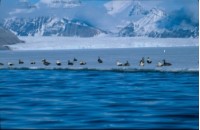The Arctic System
 A typical arctic fjord landscape with glaciers, naked mountains, sea ice and seabirds. The Arctic has long been famous for its enormous tracts of intact country, but man has played an important role in the Arctic for a long time, and still does. In the old days, people visited the region to tap its resources, but recently we have also begun to put pressure on the Arctic without actually being present.
Illustration: Tor Ivan Karlsen, Norsk Polarinstitutt (NP)
The Arctic can be described as a contradiction – varied and robust, but yet a region that is vulnerable to climate change and environmental pressures. Because a great deal of energy is transported from the south by the North Atlantic Current, the Gulf Stream, the climate in the Norwegian Arctic differs from that at the same latitude elsewhere.
A typical arctic fjord landscape with glaciers, naked mountains, sea ice and seabirds. The Arctic has long been famous for its enormous tracts of intact country, but man has played an important role in the Arctic for a long time, and still does. In the old days, people visited the region to tap its resources, but recently we have also begun to put pressure on the Arctic without actually being present.
Illustration: Tor Ivan Karlsen, Norsk Polarinstitutt (NP)
The Arctic can be described as a contradiction – varied and robust, but yet a region that is vulnerable to climate change and environmental pressures. Because a great deal of energy is transported from the south by the North Atlantic Current, the Gulf Stream, the climate in the Norwegian Arctic differs from that at the same latitude elsewhere.
The Norwegian Arctic is varied, and also complex. There are glaciers, extensive areas of tundra, high mountains, islands, skerries, fjords and enormous expanses of ocean. Changes in one part of the Arctic have an effect on conditions in other areas and give side effects for the entire system. The arctic community is a system in which everything is connected, and many species of animals and plants are specially adapted to life in these harsh surroundings. Indeed, some have become so specialised that they can only exist here.
The Arctic gives us early warning of climate change, and the region plays an important role in the global climate system. As the climate gradually gets warmer, the ice retreats and more and more islets and skerries become visible. The tundra thaws and the basis for the existence of people and animals shifts.
The ecosystem in Svalbard, the Barents Sea and other parts of the Arctic is not only coming under increasing pressure from climate change that alters nature, but also by human activity such as increasing traffic (cruise tourism, shipping, etc.), growing pressure from fisheries, extraction of natural resources and new pollutants. Norway has a political goal that the exploitation of resources must not result in species being endangered or brought to extinction.
Even though the Arctic is far away, it is nevertheless close. Events elsewhere in the world have consequences here, and changes in the Arctic have the strength and size to directly affect our everyday life. This is really not so surprising either, since the arctic regions comprise around 25 of the 90 lines of latitude. Just the areas of sea in the Arctic are 1.5 times greater than the USA, and in addition there are vast land areas in Greenland, Canada, the USA, Russia and Norway.